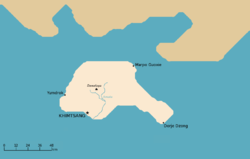Rulak
| The Free State of Rulak | |||
| |||
| Motto: Peace, Humility, Compassion | |||
| Anthem: Gyallu | |||

| |||
| Map versions | |||
| Capital | Khimtsang | ||
| Largest city | Khimtsang, Yumdrok, Dorje Dzong | ||
| Official language(s) | Common tongue, Rulakan | ||
| Official religion(s) | Temple of Rulak | ||
| Demonym | Rulakan | ||
| - Adjective | Rulakian | ||
| Government | Theocracy | ||
| - High Lama | Choygal Kamala | ||
| - Kalön Tripa | Sonam Tsangyang | ||
| - Legislature | Parliamentary Republic | ||
| Establishment | 1455 AN | ||
| Area | |||
| Population | 450,293 | ||
| Active population | 1 | ||
| Currency | Rupya | ||
| Calendar | |||
| Time zone(s) | |||
| Mains electricity | |||
| Driving side | left | ||
| Track gauge | |||
| National website | |||
| National forum | |||
| National animal | Antlered Cow | ||
| National food | Sha Phaley | ||
| National drink | Lassi | ||
| National tree | Highland Pine | ||
| Abbreviation | RUL | ||
The Free State of Rulak, commonly referred to as Rulak, is a small island nation located off the southern coast of Apollonia. It is a theocratic democracy ruled by a High Lama who serves as the head of state and a Prime Minister who acts as head of government.
History
Rulak was founded by a group of Sino-Keltian monks in 719 ASC (July 25, 2001). The monks were missionaries who had been travelling across Micras. When they reached Rulak they found it to be inhabited by a lone bull with horns that branched like a deer, which was seen as a holy sign, and they decided to settle there. The bull was cared for and called Rulak (meaning branch horn), living out its life peacefully. After the bull’s death the name became associated with the island. Originally governed by the lamas of the monastery, the Rulakans came under the influence of communist upheavals in Umoja and Proletaria, and soon experienced their own revolution in 1231 ASC (December 19, 2002). The lamaist government was replaced by the dictatorship of Tserin Hariti (Thomas Hubert), a local revolutionary-turned-general.
The communist period lasted from 1231 to 1514, during which time Rulak became a part of the Republic of Baracão, based on the nearby Islas de Libertad. Following the collapse of Baracão, Rulak briefly became part of Freenesia, but that too soon collapsed as well. Rulak was then left to fend for itself, sometimes allying with, and sometimes against, the neighboring islands. But before long it came under sway of Eura as the Kingdom of Babkha launched its campaign onto Apollonia to conquer Terre d’Riches in 1710 (April 11, 2004). This marked the beginnings of the reintroduction of monarchist and conservative politics to the island.
Babkhan ambitions on Apollonia made Rulak an ideal staging point for the crossover from Eura. It was during this time period that the island saw its largest increase in population. When Babkha and Eblis launched their war against Sennar, Rulak was at the frontlines of the fighting. Many shepherds and clavigers settled on the island, and the monastery reopened, first as a hospital and then as a religious sanctuary. For the first time in nearly two hundred years, the monks of Rulak were free to worship openly. The war against Sennar was long and costly, lasting until 1934 (November 24, 2004), after which time many Babkhans returned to Eura and Rulak’s population began to shrink again.
Antica acquired Terre d’Riches in 2349 (January 10, 2006), and Rulak along with the neighboring islands in 2428 (March 30, 2006). For the next 2500 years Rulak would remain an Antican holding, and surprisingly change little over this vast length of time. The Anticans introduced a republican government to the island that lessened years of authoritarianism by the ruling parties. This led to a renaissance of classical Lamaism and a flowering of the arts. The monastery in Khimtsang was returned to the monks and many people returned to the grassroots religion of Rulak’s earliest days. Presently the island is a successful combination of religious retreat, center for the advocacy of peace and study, and a rural getaway.

